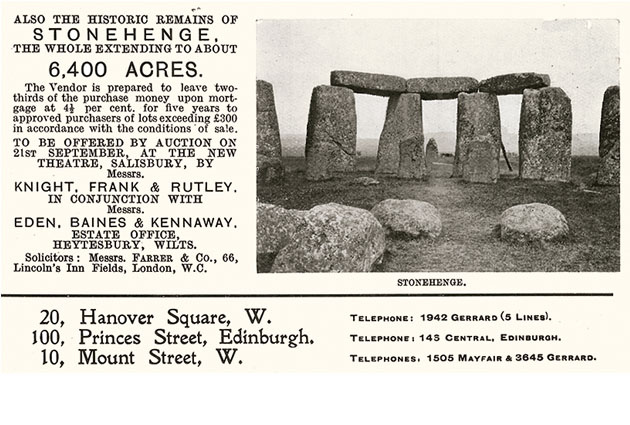Stonehenge for sale (in 1915)
‘The historic remains of Stonehenge’ were advertised for sale in Country Life in 1915, and bought by a solicitor for £6,600


Selling off the nation’s best-known ancient monument, perhaps to be dismantled and reassembled in the Arizona desert as a tourist attraction, would be unthinkable. Stonehenge has brooded mysteriously on Salisbury Plain for more than 4,000 years to the delight and perplexity of tourists, Druids, dowsers and philosophers as well as the millions who pass by on the A303, and its preservation is quite properly a major national responsibility undertaken by English Heritage.
Exactly 100 years ago, however, a grainy black-and-white photo of the famous stones casually appeared in the estate agents’ particulars for Amesbury Abbey, which was advertised for sale in a September 1915 property section of Country Life. A lot of good estates came on the market during the First World War, following the untimely death of their heirs. Sir Edward Antrobus was killed in Belgium in an early engagement and his family seat subsequently became available as a whole or in lots; Stonehenge sharing the billing with a modest farmhouse, West Amesbury Farm, with 763 acres.
In the event, Stonehenge didn’t go the way of London Bridge, famously dismantled and shipped to the USA. On September 21, 1915, at the New Theatre, Salisbury, Stonehenge in 30 acres was knocked down for £6,600 to a Wiltshire solicitor, Sir Cecil Chubb, as a birthday present for his wife. It is said that she was less than thrilled by the costly gesture. Eventually, the Chubbs generously made Stonehenge over to the nation, in a deed of gift that stipulated free and unfettered access for the public in perpetuity.
This is a rare glimpse of an unusual advertisement, because the property supplement was discarded when that particular issue of the magazine was bound and is no longer in COUNTRY LIFE’s archives. This solitary copy belonged to the writer and geometer John Michell, who wrote eloquently about sacred geometry and the enchantment of the English landscape.
Exquisite houses, the beauty of Nature, and how to get the most from your life, straight to your inbox.

